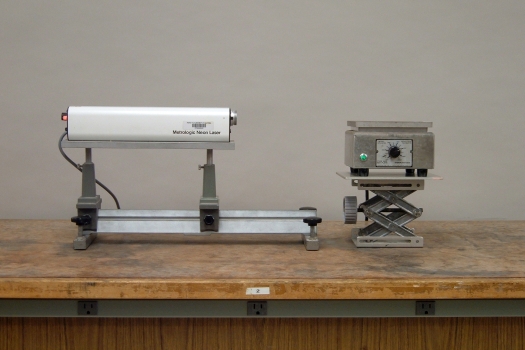 |
When a laser beam passes over a hot plate, the convection currents in the air above the plate cause the laser spot projected on a screen, to jiggle. (See video at right, above.)
Demonstration 52.11 -- Convection cell, describes the process of convection, in which heat is transferred through a medium by the motion of fluid from relatively hot regions into cooler regions. As a fluid heats, the average kinetic energy of its molecules increases, and the fluid becomes less dense. Thus, relatively hot fluid is less dense than cooler fluid, and it rises, while the cooler fluid sinks to replace it as it does so. (See demonstrations 36.34 -- diet vs. regular Coke, 36.36 -- Archimedes’ principle, 36.37 -- Cartesian divers or 36.39 -- helium-filled balloon). The hot surface of the hot plate heats the air near it, which becomes less dense than the cooler air above it, and it rises, while the cooler, denser air above it sinks. This produces convection currents near the surface of the hot plate.
The index of refraction of air is very close to one; for air at one atmosphere and 20° C, it is 1.0003. As the temperature or pressure changes, however, the density of the air changes, and thus so does its index of refraction. (The index of refraction increases as the density of the air increases.) Demonstration 80.18 -- Refraction tank, shows the phenomenon of refraction, which occurs when light passes (at a nonzero angle of incidence) from one medium into a second one, whose index of refraction is different from that of the first medium. As noted above, the heating of the air near the surface of the hot plate produces convection currents. The changes in the density of the air that produce these convection currents also result in changes in the index of refraction of the air within them. Because of this, light passing over the hot plate encounters variations in the index of refraction of the air through which it passes, with randomly oriented boundaries for the various regions that have different indices of refraction. It is thus refracted at random angles as it passes above the surface of the hot plate. This results in a random displacement of the spot that the laser beam produces on a screen; it jiggles. The video above, at right, shows this.
This is the same phenomenon that you observe, for example, when you view objects along a line that is near a hot surface, such as a road on a hot day, or when you view objects through the exhaust plume from a truck. On a larger scale, a similar phenomenon causes stars to twinkle, and blurs the images formed by telescopes. Temperature gradients in the atmosphere, and the resulting air currents, cause fluctuations in the index of refraction along the path via which light from celestial objects reaches us at the earth’s surface.
It also bears noting that besides the convection currents, the hot plate produces a density gradient, and thus a gradient in the index of refraction, in the air above it. The air nearest the plate is hottest, and is thus the least dense. As the distance above the plate increases, the temperature decreases, and the density of the air increases. The index of refraction of the air is thus least nearest the hot plate, and increases with distance above the hot plate. Light traveling perpendicular to such a gradient is bent in the direction of increasing index of refraction. The laser beam traveling horizontally near the surface of the plate is thus deflected upward, and the average location of the spot it produces on the wall is slightly higher than it would be without the hot plate present. Because the path across the hot plate is short, this effect is fairly small, but it does occur. This same effect is responsible for the phenomenon known as a mirage, a common example of which occurs when light passing near the hot surface of a road is refracted upward toward the eyes of a driver or pedestrian traveling on the road. The driver or pedestrian sees what looks like a pool of water on the road some distance away, but is really an image of the sky, the light rays from which pass near the road and are refracted upward into the person’s eyes.
References:
1) Halliday, David and Resnick, Robert. Physics, Part Two, Third Edition (New York: John Wiley and Sons, 1977), p. 939.